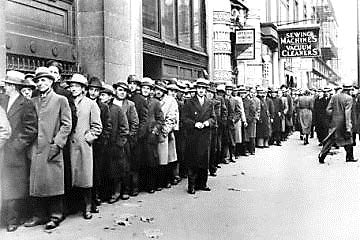‘New Keynesian’ unemployment — a paid vacation essentially!
Lars P. Syll
Both Real Business Cycle and New Keynesian models see unemployment as an accidental and sometimes necessary outcome in a financial downturn. Their models allow for unemployment as an efficient way of rebalancing the economy back into equilibrium. In effect they have no idea why unemployment happens. In other words, these models have no predictive power or understanding of what is happening in the economy.
The following commentary by Lars P. Syll has been extracted from an entry that appeared in his blogsite on 11 March, 2024 [1].
In the basic DSGE models used by the New Classical and ‘New Keynesian’ macroeconomists, the labour market is always cleared; in her response to a changing interest rate, expected life-time incomes, or real wages, the representative agent maximizes the utility function by varying her labour supply, money holding and consumption over time. Most importantly, if the real wage deviates from its ‘equilibrium value,’ the representative agent adjusts her labour supply, so that when the real wage is higher than its ‘equilibrium value,’ the labour supply is increased, and when the real wage is below its ‘equilibrium value,’ labour supply is decreased.
In this model world, unemployment is always an optimal choice for changes in labour market conditions. Hence, unemployment is totally voluntary. To be unemployed is something one optimally chooses to be a kind of prolonged vacation.
Although this picture of unemployment as a kind of self-chosen optimality, strikes most people as utterly ridiculous, there are also, unfortunately, a lot of mainstream economists who still think that price and wage rigidities are the prime movers behind unemployment. DSGE models basically explain variations in employment (and a fortiori output) assuming nominal wages are more flexible than prices disregarding the lack of empirical evidence for this rather counterintuitive assumption.
Lowering nominal wages would not clear the labour market. Lowering wages and possibly prices could, perhaps, lower interest rates and increase investment. It would be much easier to achieve that effect by increasing the money supply. In any case, wage reductions were not seen as a general substitute for an expansionary monetary or fiscal policy. And even if potentially positive impacts of lowering wages exist, there are serious negative impacts deteriorating industrial relations, expectations of ongoing lowering of wages causing a delay of investments, debt deflation etc.

Obviously, it’s rather embarrassing that the kind of DSGE economic models used by ‘modern’ macroeconomists cannot incorporate such a basic reality as involuntary unemployment. Of course, working with representative agent models, this should come as no surprise. The kind of unemployment that occurs is voluntary since it is only adjustments of the hours of work that these optimizing agents make to maximize their utility.
And as if this is nonsense economics is not enough, in New Classical and ‘New Keynesian’ macroeconomists DSGE models increases in government spending lead to a drop in private consumption! How on earth does one arrive at such as bizarre view?
In the most basic mainstream proto-DSGE models, one often assumes that governments finance current expenditures with current tax revenues. This will have a negative income effect on the households, leading — rather counterintuitively — to a drop in private consumption although both employment and production expand. This mechanism also holds when the (in)famous Ricardian equivalence is added to the models.
Ricardian equivalence basically means that financing government expenditures through taxes or debts is equivalent, since debt financing must be repaid with interest, and agents — equipped with rational expectations — would only increase savings to be able to pay the higher taxes in the future, thus leaving total expenditures unchanged.
1. https://larspsyll.wordpress.com/2024/03/11/new-keynesian-unemployment-a-paidvacation-essentially-2/




















